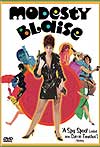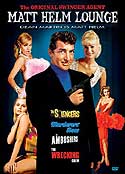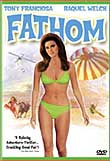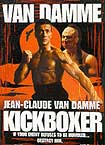|
James Bond's Imitators:
Bond's knock-offs and imitators included the following serious
(and spoofing) characters and films:
- a secret agent named Hubert Bonnisseur de la Bath—alias
O.S.S. 117, was created by French thriller novelist Jean de Bruce; the
character was a wealthy Louisiana gentleman who spied for the American
OSS, and was found in a number of films (pre- and post-Bond) popular with
European audiences: OSS 117 Is Not Dead (1956, Fr) (aka OSS
117 N'Est Pas Mort), O.S.S. 117: Double Agent (1967) and No
Roses For OSS 117 (1968, Fr) (aka Pas De Roses Pour OSS 117)
- both with John Gavin as the agent
- another similar agent in France was named Francis Coplan,
in Coplan Secret Agent FX 18 (1964, Fr)
- Norman Taurog's spy spoof Dr. Goldfoot and the Bikini
Machine (1965), a predecessor of the Austin Powers films, starred
Vincent Price in a campy role as the title character who invented exploding
bikini-clad women and threatened the world, and Frankie Avalon as secret
agent Craig Gamble; the sequel was Mario Bava's Dr. Goldfoot and the
Girl Bombs (1966) (aka The Amazing Dr. G, and The Spy Who
Came In From the Fairly Cold), again with Vincent Price as a megalomaniac
with more exploding fembots (with the detonation device in their belly
buttons)
 Joseph
Losey's light-hearted, James Bond spy comedy-spoof Modesty Blaise (1966), was based upon a British newspaper comic
strip series, with Italian star Monica Vitti (in her first English-language
film) in the title role opposite Dirk Bogarde as the villain Joseph
Losey's light-hearted, James Bond spy comedy-spoof Modesty Blaise (1966), was based upon a British newspaper comic
strip series, with Italian star Monica Vitti (in her first English-language
film) in the title role opposite Dirk Bogarde as the villain- Robert Vaughn was master spy Napoleon Solo (code-named
The Man From U.N.C.L.E., a government enforcement agency meaning the United
Network Command for Law and Enforcement) who frequently battled the evil
T.H.R.U.S.H. (Technological Hierarchy for the Repression of Undesirables
and the Subjugation of Humanity), in To Trap A Spy (1966), the
original pilot for the popular TV series in the 60s released as a theatrical
film; Vaughn was partnered with David McCallum as blonde-haired Russian
secret agent Illya Kuryakin
- the 'Harry Palmer' spy mystery trilogy featured a reluctant,
bespectacled, unglamorous British secret serviceman (Michael Caine) (from
the best-selling novel by Len Deighton) in The Ipcress File (1965), Funeral in Berlin (1967) and Billion Dollar Brain (1967);
also two other obscure follow-up action/spy thriller films with Michael
Caine reprising his role were: Bullet to Beijing (1995) and Midnight
in St. Petersburg (1997)
 James
Coburn starred as Derek Flint, a playboy hero in the spy films: Our
Man Flint (1966), and In Like Flint (1967); Flint was an agent
of Z.O.W.I.E. (Zonal Organization World Intelligence Espionage); Ray Danton
also played Flint in a 1976 TV pilot James
Coburn starred as Derek Flint, a playboy hero in the spy films: Our
Man Flint (1966), and In Like Flint (1967); Flint was an agent
of Z.O.W.I.E. (Zonal Organization World Intelligence Espionage); Ray Danton
also played Flint in a 1976 TV pilot- an American version of 'Harry Palmer' with a Harold Pinter
screenplay from the first of Adam Hall's many Quiller novels -
was Quller, an agent (George Segal) called upon by Alec Guinness to infiltrate
the neo-Nazis (led by Max von Sydow) in post-war Berlin, in The Quiller
Memorandum (1966)
- Columbia contract star Dean Martin portrayed Matt Helm
(based on the spy in Donald Hamilton's novels) in four tongue-in-cheek
films between 1966 and 1968: The Silencers (1966), Murderer's
Row (1966), The Ambushers (1967), and The Wrecking Crew
(1968); none of the films' titles had anything to do with their plots;
Helm was a cheesecake model photographer-turned-American agent for ICE
(Organization for Intelligence and Counter-Espionage)
- Richard Johnson was featured in the resurrected role
of British agent Bulldog Drummond (a suave, gentleman-spy hero in many
films mostly made between the silents through to the late 40s) in Deadlier
Than the Male (1967) and Some Girls Do (1969)
- Neil Connery (Sean Connery's/James Bond's brother) appeared
in an action-spy film titled Operation Kid Brother (1967) (aka O.K. Connery), also featuring perennial Bond characters Bernard
Lee and Lois Maxwell (although not identified as M or Miss Moneypenny)
- Frankie Avalon (and B-movie hunk George Nader) starred
as US espionage agents teamed with British intelligence to combat Goldfinger's
Shirley Eaton as the beautiful but deadly Su-Muru (a character based on
a series of Sax Rohmer novels) intent on world domination with a vast
band of man-hating women, in The Million Eyes of Sumuru (1967) (aka The 1000 Eyes of Su-Muru)
 David
Niven headlined Casino Royale (1967) - a direct spoof of the James
Bond character David
Niven headlined Casino Royale (1967) - a direct spoof of the James
Bond character - sexy Raquel Welch sizzled as Fathom Harvill, a champion
sky diver recruited by a Western spy organization for a top secret mission
in Fathom (1967), co-starring Tony Franciosa as millionaire Peter
Merriwether, who was believed to possess an H-bomb detonator known as
the Fire Dragon
- When Eight Bells Toll (1971) was adapted from Alistair MacLean's bestselling book, and set in the Scottish
Highlands, with Anthony Hopkins in a Bond-like role as Philip Calvert
in a search for missing/stolen government gold bullion
- The Tall Blond Man with One Black Shoe (1972, Fr.) was a wacky French spy comedy with Pierre Richard, followed by a sequel
two years later: The Return of the Tall Blond Man with One Black Shoe
(1974)
- Le Magnifique (1973, Fr.) (aka How to Destroy
the Reputation of the Greatest Secret Agent in the World), was a spy-comedy
parody of the James Bond films, starring Jean Paul Belmondo
- John Landis' 'Road' spy comedy Spies Like Us (1985) featured Chevy Chase and Dan Aykroyd as two aspiring but misfit CIA agents
- the spy-comedy spoof, Leonard,
Part 6 (1987), a big flop, starred Bill Cosby as ex-agent Leonard
Parker engaged in a mission to stop the evil Medusa (Gloria Foster)
- If Looks Could Kill (1991) - the feature film debut of Richard Grieco, a teen-oriented spoof of the James Bond films
- The Double O Kid (1992) was another juvenile-oriented spoof/parody about a youthful rookie spy
(Corey Haim)
- Spy Hard (1996), a low-brow
spy comedy, with Leslie Nielsen as Dick Steele (Agent WD-40), with aid
from Russian agent Veronique Ukrinsky (Nicolette Sheridan), against armless
mad-man villain Andy Griffith - who has plans to conquer the world
- writer/director Luc Besson's action thriller La Femme
Nikita (1990) (aka Nikita), was a significant spy film about
a young female political assassin (played by Besson's wife Anne Parillaud);
remade in Hong Kong as Black Cat (1991) and in the US by director
John Badham as Point of No Return (1993) with Bridget Fonda
- Mike Myers appeared as the International Man of Mystery
in the satirizing spy spoofs Austin Powers: International Man of Mystery
(1997), Austin Powers: The Spy Who Shagged Me (1999), and Austin
Powers in Goldmember (2002), all by director Jay Roach
- Johnny English (2003), a
comedy of errors spy film with Rowan Atkinson (known for roles as Mr.
Bean) as the bumbling superspy title character, another funny parody of
the James Bond films
- Robert Rodriguez' stunt-filled Spy Kids (2001),
was about young agents Alexa Vega (as Carmen) and Daryl Sabara (as Juni),
children of a pair of secret agents, who must save their parents; sequels
included Spy Kids 2: The Island of Lost Dreams (2002), and Spy
Kids 3-D: Game Over (2003)
- Malcolm in the Middle star Frankie Muniz was teenaged
CIA super-agent Banks in Agent Cody Banks (2003), and the sequel Agent Cody Banks 2: Destination London (2004)
Blaxploitation Films:
So-called 'blaxploitation' films (because they reinforced
negative stereotypes and patronized viewers with formulaic action/crime film
plots and characters) with African-American stars were very popular with black
film audiences in urban theatres for awhile. They were launched in the early
to mid-1970s with Melvin Van Peebles' Sweet Sweetback's Baadasssss Song
(1971), and Shaft (1971) (remade in 2000), starring Richard
Roundtree, and Superfly (1972). There were black westerns, sci-fi fantasies,
even black horror films (such as Blacula (1972)) that took advantage
of this sub-genre's short-lived box-office appeal.
Foreign Shore Influences on the Action Film: Martial
Arts
 The
popular, Hong Kong kung fu genre was catapulted to world-wide
prominence in the 1970s with Bruce Lee's four martial-arts films,
with spectacularly intense fight scenes. Unfortunately, many of them
were dubbed and had poorly-contrived plots containing copy-cat James
Bond elements. Lee's best films were his last two - they were released
post-humously after he died at the young age of 32: The
popular, Hong Kong kung fu genre was catapulted to world-wide
prominence in the 1970s with Bruce Lee's four martial-arts films,
with spectacularly intense fight scenes. Unfortunately, many of them
were dubbed and had poorly-contrived plots containing copy-cat James
Bond elements. Lee's best films were his last two - they were released
post-humously after he died at the young age of 32:
- Fists of Fury (1971) - Lee's first film
- The Chinese Connection (1972)
- The Way of the Dragon (1972), billed as Enter
the Dragon's 'sequel' Return of the Dragon (1974) when it
was released in the US in 1974; it was Lee's writing and directorial
debut film; it co-starred Chuck Norris (a former karate champion) in
a rare villainous role as Colt who fought against Lee in a climactic
Roman Coliseum scene; Lee played the part of Tang Lung, a country bumpkin
type sent from his family in Hong Kong to Rome to help out a relative
whose Chinese restaurant was targeted by a crime mob; the film was the
first Hong Kong action movie ever to be shot in the West
- the fast-paced Enter the Dragon (1973) with
Lee in his first (and last) English-language (and Hollywood-produced)
film; it was the first kung
fu film produced by a major Hollywood studio; in the film, Lee (who
choreographed the action) portrayed a martial arts expert seeking
revenge on a gang that killed his sister, by entering a martial arts
competition hosted by the kingpin (John Saxon)
Lee's life story was told in Dragon: The Bruce Lee
Story (1993), with star Jason Scott Lee as the martial arts
Hong Kong action hero.
 A
variant on the martial-arts films has been found in the films of Jackie
Chan (nicknamed the "Buster Keaton of Kung-Fu") and his
numerous 80s and 90s Hong-Kong and US-produced action comedies. [Note:
Chan had starred in Lee's Enter the Dragon (1973) as a Thug
in Prison.] Success finally arrived for Chan with Rumble
in the Bronx (1996), Rush
Hour (1998), Shanghai Noon (2000), Rush Hour 2 (2001), The
Tuxedo (2002),
and Shanghai Nights (2003). A
variant on the martial-arts films has been found in the films of Jackie
Chan (nicknamed the "Buster Keaton of Kung-Fu") and his
numerous 80s and 90s Hong-Kong and US-produced action comedies. [Note:
Chan had starred in Lee's Enter the Dragon (1973) as a Thug
in Prison.] Success finally arrived for Chan with Rumble
in the Bronx (1996), Rush
Hour (1998), Shanghai Noon (2000), Rush Hour 2 (2001), The
Tuxedo (2002),
and Shanghai Nights (2003).
Belgian star Jean-Claude Van Damme starred in a variant of
the Asian martial-arts films - the action-filled kickboxer film, as in Bloodsport
(1988), Black Eagle (1988), Kickboxer (1989), Death Warrant
(1990), Double Impact (1991), Nowhere to Run (1993), and Hard Target (1993).
US films influenced by the martial arts craze included The
Karate Kid (1984) and The Karate Kid, Part II (1986), Teenage
Mutant Ninja Turtles (1990) and Teenage Mutant Ninja Turtles II: The
Secret of the Ooze (1991), Blade (1998) and Blade II (2002),
and the video-game adaptation Mortal Kombat (1995). And
Ang Lee's lyrical arthouse film Crouching Tiger, Hidden Dragon (2000),
the winner of the Best Foreign Film Oscar and three others (Best Art Direction,
Best Cinematography, and Best Score), was a spectacular and entertaining martial
arts entry.
John Woo: 1980's Hong Kong Action Films and Their Enduring
Influence
Violent and graphic action films (as well as gangster flicks)
also owe a debt to Hong Kong's legendary John Woo, who helped to shape the
genre with scenes of stylish choreography in The Killer (1989) and
the visceral Hard-Boiled (1992), both with Chow Yun-Fat in the lead
role. The Killer (1989) was the most popular Hong Kong film in the
US since Bruce Lee's Enter the Dragon (1973). Woo's films were noted
for slow-motion sequences and face-to-face standoffs, and would influence
the later works of both Quentin Tarantino and Robert Rodriguez.
John Woo's intense and intelligent action film Face/Off
(1997) featured a stolen-identity plot with Nicolas Cage and John Travolta
in the good/evil roles. Woo's sequel film Mission: Impossible 2 (2000) to the inferior 1996 Brian De Palma version Mission: Impossible (1996) was filled with exciting, no-holds-barred action sequences. |
